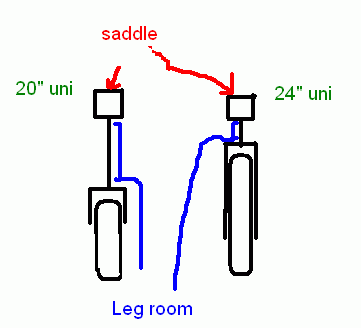I have been reading all over the place that a freestyle unicycle is a 20". Is this actually set in stone? Will a 24" work just as well? What advantages and/or disadvantages does it have over a 20"?
JSM rides a 24", and swears by it. You’ll find that the wheel is a bit less responsive to being forced to do things it doesn’t want to, and you’ll have to play to it more. Also, any skill where your leg has to cross over to the opposite pedal across the tire (seat on side) will be more problematic as the wheel is taller.
It’s a preference thing, generally it’s considered easier to use a 20", however it’s quite possible to be very good with a 24". Unicycling is more about the rider than the machine in any case!
The general idea is that it is easier to do most tricks on a 20". I find that on a 24" you dont have much room to fit your foot on the frame, you leg has to really bend to get there, whereas on a 20" youve got the longer seat post and a crown which is much further down. This seems to be where the problem occurs unless you’ve got your saddle up nice and high on your 24".

That was an exaggeration by a lot, Brian, but you get the idea.
i think it was a perfect representation.
anyway…back in the late 80’s early 90’s when unicycling was getting popular, most of the freestyle riders were using 24" wheels. then at a convention, the Japanese used 20" wheeled freestyle unis instead, and they were AWESOMe. so most people switched.
I thiiink thats the story behind it…I remember johnfoss telling it once. i should just wait till he comes to tell it properly. consider this a preview.
Yeah, more like this maybe…

I don’t think a 24" unicycle is better than a 20" for freestyle, but it does work. Just yesterday I rode out of backward seat drag on my 24". So if you have only a 24" unicycle, don’t be discouraged from learning freestyle. With practice, you should be able to do anything you can do on a 20" except cross over riding. On the other hand, if you have a 20", use it, because it will probably be easier in the long run.
There are several advantages to a 24", but these are probably outweighed by its problems. A 24" is bigger, faster, and has more momentum. This might come in handy for some things, side ride for instance. The size factor might also make it visually more appealing for things like stand-up tricks. (You get a couple extra inches.) You don’t have to lean down so far for hand wheel walk. The wheel is bigger, and give you more space for foot wheel walk. Since you’re higher up on a 24", you have more time to land on your feet when you fall.
Some corrections:
I came along in 1980, when we Americans were mostly riding 24" Schwinns, and using them for everything. Ahh, a simpler time. There are still people out there who want to keep it where you only need one unicycle for everything. Fine, but please don’t prevent us from growing the sport and conventions! Oh, sorry, end rant.
Anyway, the first big splash by 20" wheels was perhaps made by the three guys from Sweden who came in 1981. They were Joaquim Malm, Peter Holmgren, and Hakan Frurskar (spelling undoubtedly wrong). Joaquim Malm is credited with the invention of coasting. And the three of them, more or less as a group, are credited with the introduction of seat drag, bouncing seat on floor, gliding and a whole general “1980s Swedish style” of unicycling. Theirs was perhaps a precursor to Street riding, but done indoors and not yet involving obstacles. But their quick, sudden movements style of riding very much lent itself to a small, lightweight wheel. They took advantage of the lightness and hard bumpers of the Miyata Deluxe unicycles of the day, and others followed.
Oh, and those three had a younger guy who wanted to be like them, but lived pretty far away. He got better. His name is Peter Rosendahl (http://www.peter-rosendahl.com).
I stuck with 24" through 1983, but in 1984 got a 20" and started converting over. I remember a few frustrating months where that smaller wheel was not behaving as I’d expected it to, but after I got used to it, I was able to make use of its advantages.
- Coasting, gliding, possibly standup skills made easier by longer gap between seat and fork crown
- Quick movements easier due to lighter wheel
- Pairs riding easier due to smaller wheel
And this is a major one, though I didn’t learn it until a little bit later
- On a 20" wheel, you can do the same performance in a smaller space than on a 24", period. This makes a big difference when your performing space is an elementary school stage or other very limited space!
But the 24" also has advantages, as JSM mentioned. Speed, momentum, and visual size. Spins are easier for two reasons. Your pedals are much less likely to hit the ground, and the higher speed per revolution allows for more spinning options. Extra weight = momentum, as in the side ride like JSM said. Same can apply to other moves. And if you have an audience, a 24" wheel is going to look more impressive than a 20", especially if you’re a really tall person.
For wheel walking, once you’ve got the technique down, wheel size is not an issue. I find it easier on the 20" because my legs have more room to move around. This is why it’s so hard on a Coker; your knees have to be much higher and the position is more awkward.
Sem & Teresa are a great example of top professional performers on 24" wheels. Though they don’t do a lot of 20" style tricks, it’s not because they can’t, it just isn’t their style. When I think of world champions over the years, at least in the individuals, I think nearly all of them were on 20" wheels. This includes Teresa, who was the first women’s champion.
Carol Bahorich (now Carol Bricker, who hosted NAUCC 2004 in Salt Lake City), won at Unicon II on a 24" Miyata. Her sister Wendy (now Gryzch; hosted MUni events last summer in Bowling Green) used a 24" in 1988 and I’m pretty sure she was the winner at Unicon IV.
And there it is…Ohh isnt Peter Rosandahl in Genius book of records a couple times?
as with most things its a matter of preference. like you could do trials ona 24 tho its not recomended. you could tdo freestyle on a 24 but it will be a little less manueverable and and heavier. but still a matter of preference.
that 24" drawing looks more like a coker! and the 20" looks like a Hub!![]()
Scale wise it would be a 56" wheel, with a 20" seat post, making the minimum leg length over 55", a rider just over 11 feet high. The 20" wheel would have a seat post 50 inches long, requiring a miminum leg length of over 65" a rider just under 13 feet tall!
Good luck.
Besides for that, the drawing illustrates the advantages and disadvantages adequately.
Hey, I’ve ridden a 56" wheel before, and I’m way under 11’! It had a pretty short seat post though…
For Caw89, Peter Rosendahl has had probably a dozen or more Guinness records. Check out the web site!
Holy crap people, its MS Paint, im not going to produce a work of art. It got the point across did it not?